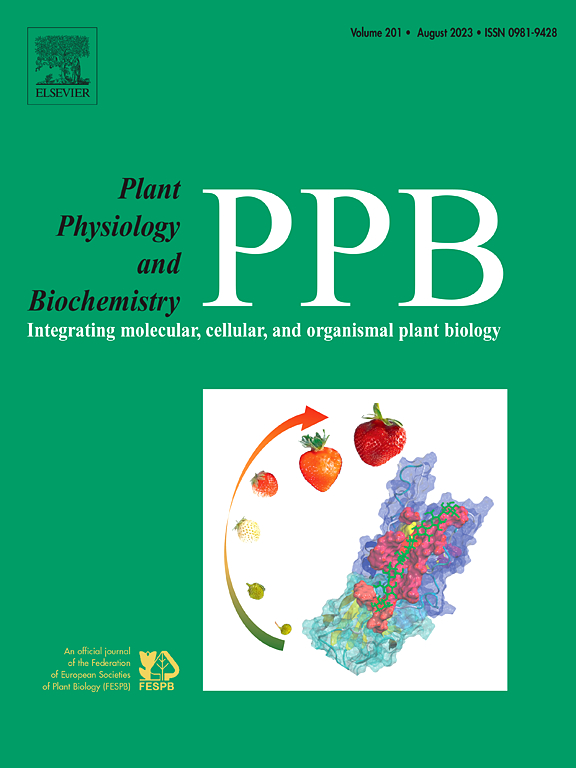使砷在植物中吸收、转运和解毒的运输通道
IF 6.1
2区 生物学
Q1 PLANT SCIENCES
引用次数: 0
摘要
砷(As)是一种有毒的类金属和全球性的环境污染物,通过地下水和饮食暴露对生物构成严重威胁。急性和慢性暴露于砷会导致生物体严重的生理和生化紊乱。在植物中,As的吸收是通过必需金属离子的转运体进行的,由于As种类和必需离子之间的结构相似性,这些转运体通常缺乏选择性。结节蛋白26样内在蛋白(NIPs)促进As(III)、二甲基larsinic酸(DMA)和单甲基larsonic酸(MMA)的运输,而磷酸盐转运蛋白(PHTs)由于其与磷酸盐的相似性而介导As(V)的摄取。内化的砷通过富含硫(S)的分子如谷胱甘肽(GSH)和植物螯合素(PCs)解毒,形成硫醇-砷复合物。这些复合物要么被运送到茎中进行隔离,要么储存在液泡中,从而降低毒性。解毒依赖于硫酸盐转运体(SULTRs)的S摄取和atp结合盒(ABCC)转运体的液泡隔离硫醇- as复合物。了解这些分子机制对于减轻砷毒性至关重要。本文综述了转运蛋白在砷解毒中的作用及其调控。这些转运体是基因组编辑和分子育种的有希望的目标,可以开发出食用组织中砷含量较低的作物,解决食品安全和环境修复问题。本文章由计算机程序翻译,如有差异,请以英文原文为准。
Transport channels enabling uptake, translocation and detoxification of arsenic in plants
Arsenic (As), a toxic metalloid and global environmental contaminant, poses serious threats to living organisms through groundwater and dietary exposure. Both acute and chronic exposures of As result in severe physiological and biochemical disturbances in organisms. In plants, As uptake occurs through transporters for essential metal ions, which often lack selectivity due to structural similarities between As species and essential ions. Nodulin 26-like intrinsic proteins (NIPs) facilitate the transport of As(III), dimethylarsinic acid (DMA), and monomethylarsonic acid (MMA), while phosphate transporters (PHTs) mediate As(V) uptake due to its similarity to phosphate. Internalized As is detoxified through sulfur (S)-rich molecules like glutathione (GSH) and phytochelatins (PCs), forming thiol-As complexes. These complexes are either transported to shoots for sequestration or stored in vacuoles, reducing toxicity. Detoxification relies on sulfate transporters (SULTRs) for S uptake and ATP-binding cassette (ABCC) transporters for vacuolar sequestration of thiol-As complexes. Understanding these molecular mechanisms is crucial for mitigating As toxicity. This review outlines the roles of transporters and their regulation controlling As detoxification. These transporters are promising targets for genome-editing and molecular breeding to develop crops with reduced As levels in edible tissues, addressing food safety and environmental remediation.
求助全文
通过发布文献求助,成功后即可免费获取论文全文。
去求助
来源期刊
CiteScore
11.10
自引率
3.10%
发文量
410
审稿时长
33 days
期刊介绍:
Plant Physiology and Biochemistry publishes original theoretical, experimental and technical contributions in the various fields of plant physiology (biochemistry, physiology, structure, genetics, plant-microbe interactions, etc.) at diverse levels of integration (molecular, subcellular, cellular, organ, whole plant, environmental). Opinions expressed in the journal are the sole responsibility of the authors and publication does not imply the editors'' agreement.
Manuscripts describing molecular-genetic and/or gene expression data that are not integrated with biochemical analysis and/or actual measurements of plant physiological processes are not suitable for PPB. Also "Omics" studies (transcriptomics, proteomics, metabolomics, etc.) reporting descriptive analysis without an element of functional validation assays, will not be considered. Similarly, applied agronomic or phytochemical studies that generate no new, fundamental insights in plant physiological and/or biochemical processes are not suitable for publication in PPB.
Plant Physiology and Biochemistry publishes several types of articles: Reviews, Papers and Short Papers. Articles for Reviews are either invited by the editor or proposed by the authors for the editor''s prior agreement. Reviews should not exceed 40 typewritten pages and Short Papers no more than approximately 8 typewritten pages. The fundamental character of Plant Physiology and Biochemistry remains that of a journal for original results.

 求助内容:
求助内容: 应助结果提醒方式:
应助结果提醒方式:


